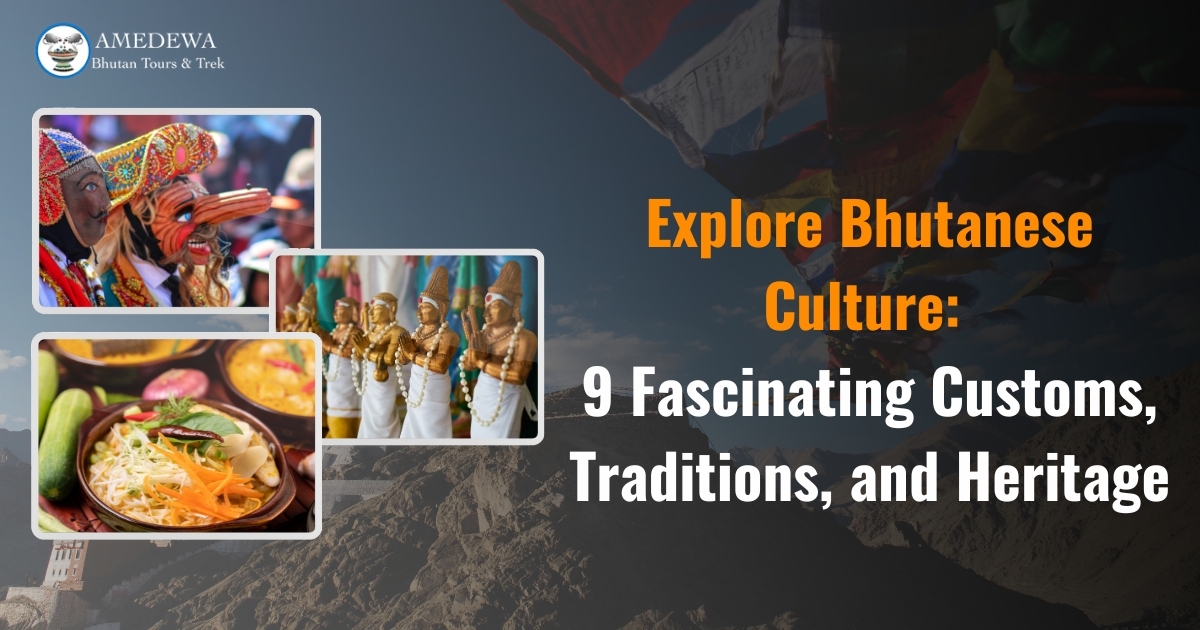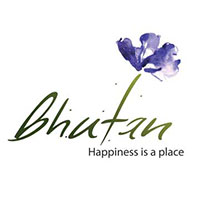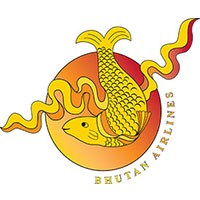Posted On: February 14, 2025 | By: adminadmin
Explore Bhutanese Culture: 9 Fascinating Customs, Traditions, and Heritage
Bhutan, often known as the “Land of the Thunder Dragon,” is a magical monarchy in the Eastern Himalayas that is known for its breathtaking scenery, rich cultural heritage, and long-standing customs. As Bhutan sets a high value on preserving its history while striking a balance with modernity, its culture is still among the best kept in the world.
Bhutanese customs provide a fascinating glimpse into the country’s way of life, from colorful celebrations and distinctive religious rituals to traditional dress and national sports. Let’s explore nine key elements of Bhutanese culture that set this country apart.
1. Traditional Clothing: A Symbol of National Identity
In Bhutanese culture, traditional attire is essential since it symbolizes the nation’s history, identity, and cohesion. The Gho, a knee-length robe tied at the waist with a kera belt made from cloth, is worn by males from Bhutan. Additionally, they wear kabney, a white scarf that represents their status or rank.
The Kira, an ankle-length dress, is worn by women with a short jacket called Toego and a long-sleeved top called wonju. The finely woven materials used to make these outfits showcase Bhutan’s skill in textile design. To maintain Bhutan’s cultural identity, traditional dress is required at government buildings, schools, and ceremonial events.
2. Tsechus: Bhutan’s Colorful Festivals
The colorful Tsechus festivities are among the most fascinating facets of Bhutanese culture. These religious festivals, which honor Guru Rinpoche, the founder of Tibetan Buddhism, are held at monasteries and dzongs (fortresses) throughout the nation.
Tsechus depicts tales of virtue overcoming evil via elaborate art, folk music, and masked dances. The most well-known are Paro and Thimphu Tsechu, which draw both residents and visitors. These celebrations also provide communities a chance to unite while wearing their best clothes in honor of Bhutan’s rich spiritual and cultural legacy.
3. Spiritual Practices and Sacred Monasteries
Buddhist spirituality is deeply rooted in Bhutanese culture. Numerous monasteries, temples, and other places of worship may be found across the nation, and monks are crucial to the preservation of religious philosophy.
Perched spectacularly on a cliffside, Taktsang Monastery, also known as the Tiger’s Nest, is one of Bhutan’s most recognizable monuments. For both residents and tourists, it is an important place of pilgrimage. By praying, meditating, and burning butter lamps at monasteries, Bhutanese people integrate spirituality into their everyday life. Bhutan is lined with vibrant prayer flags and wheels that represent blessings for wealth and peace.
4. Bhutanese Etiquette and Social Customs
The people of Bhutan are renowned for their warmth, deference, and strong feeling of community. In Bhutan, “Kuzuzangpo La” is the traditional welcome, which is frequently accompanied by a smile and a little bow.
Respect for elders and religious leaders is emphasized in social conventions. Before entering a Bhutanese house, guests are supposed to take off their shoes, and they may provide modest presents as a token of gratitude. Bhutanese food is usually served in a communal setting to promote a sense of community and sharing.
5. Archery: Bhutan’s National Sport
In Bhutan, archery (Dha) is more than simply a sport; it is a cherished national hobby that embodies the country’s customs, friendship, and spirit of competition. Teams compete in archery events all around the nation, trying to hit targets that are 140 meters apart—much farther than in Olympic archery.
Singing, dancing, and playful knocks amongst participants are all part of these joyous competitions. Archery contests are a vibrant and richly cultural event because of the loud cheers and celebration songs and dances of the spectators.
6. Bhutanese Cuisine: A Flavorful Experience
The distinctive spicy tastes and organic ingredients of Bhutanese cuisine set it apart. A basic food, rice—especially red rice—is frequently paired alongside spicily flavorful meat and vegetable dishes. Ema Datshi, a fiery stew cooked with cheese and chili peppers, is the most well-known cuisine from Bhutan.
Other popular dishes include:
- Phaksha Paa – pork cooked with red chilies, is another well-liked meal
- Jasha Maroo – Spicy chicken stew
- Momo – Steamed dumplings stuffed with veggies or meat
Bhutanese eating customs also heavily rely on drinks like Ara, a regional rice wine, and Suja, a butter tea. Usually consumed in a group surroundings, meals build social and familial ties.
7. Bhutan’s Commitment to Cultural Preservation
Bhutan is well known around the world for its commitment to conserving its cultural legacy. The nation adheres to the Gross National Happiness (GNH) ideology, which places a higher priority on environmental protection, sustainable development, cultural preservation, and good governance than on economic expansion.
Bhutan has strict regulations to safeguard its cultural identity, such as laws requiring traditional attire, language preservation, and eco-friendly travel activities. By taking these steps, Bhutan can embrace modern advances while preserving its way of life.
8. Language and Education: Keeping Traditions Alive
The goal of Bhutan’s educational system is to prepare pupils for modern life while preserving ancient traditions. Although Dzongkha is the official language of the nation, English is frequently utilized in administration and education.
To keep future generations linked to their roots, schools place a strong emphasis on traditional arts and crafts, environmental conservation, and Bhutanese values. As part of their cultural education, Bhutanese pupils also study local music, traditional dance, and scripture.
9. Sustainable Development and Environmental Conservation
Bhutan is a pioneer in environmental sustainability on a worldwide scale. It absorbs more carbon dioxide than it emits, making it the only carbon-negative nation in the world. To preserve the nation’s pure ecology, the government implements laws that support renewable energy, organic farming, and forest protection.
The country’s natural and cultural legacy is protected by Bhutan’s strict tourist laws, which are referred to as “High-Value, Low-Impact” tourism. During their visit, guests are urged to support local communities and adopt eco-friendly travel habits.
Conclusion: Experience Bhutan’s Unique Culture
Bhutan is one of the most distinctive travel destinations in the world because of its traditions, customs, and cultural heritage. Bhutan provides a rich and immersive cultural experience, from its colorful festivals and deeply ingrained spiritual rituals to its traditional clothing and national sport.
Are you ready to discover Bhutan’s wonders? With their meticulously planned tours and treks, Amedewa Bhutan Travel Agency ensures a once-in-a-lifetime experience in this captivating Himalayan nation.
Book your trip to Bhutan with Amedewa Bhutan Travel Agency right now to experience the essence of Bhutanese culture up close!





